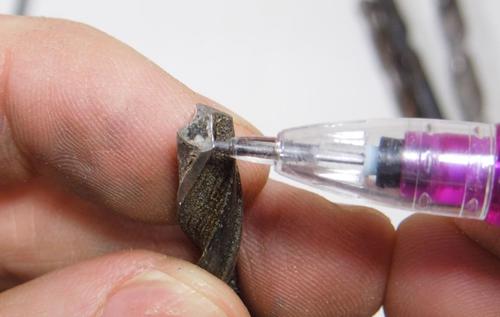 Here's a twist drill that has lost its edge (click picture to enlarge). While dull
bits still drill ok in woods on a drill press, they won't cut very clean and also get too
hot. For drilling in metal, a dull drill just plain won't drill.
Here's a twist drill that has lost its edge (click picture to enlarge). While dull
bits still drill ok in woods on a drill press, they won't cut very clean and also get too
hot. For drilling in metal, a dull drill just plain won't drill.
 Here's a twist drill that has lost its edge (click picture to enlarge). While dull
bits still drill ok in woods on a drill press, they won't cut very clean and also get too
hot. For drilling in metal, a dull drill just plain won't drill.
Here's a twist drill that has lost its edge (click picture to enlarge). While dull
bits still drill ok in woods on a drill press, they won't cut very clean and also get too
hot. For drilling in metal, a dull drill just plain won't drill.
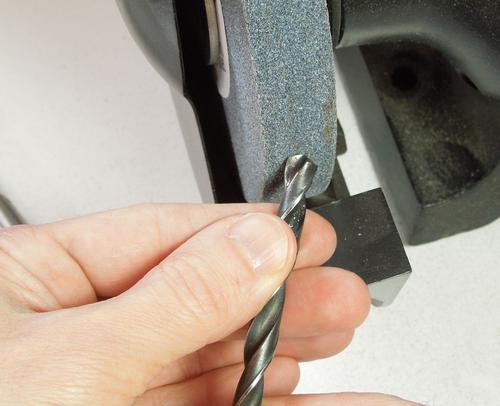 There are all kinds of complicated jigs and gadgets out there for
sharpening drill bits. But the fact is, twist drill bits are actually quite
easy to sharpen by hand. And if you mess up, the worst that can happen is
that you grind away a few millimeter of drill until you get it right.
There are all kinds of complicated jigs and gadgets out there for
sharpening drill bits. But the fact is, twist drill bits are actually quite
easy to sharpen by hand. And if you mess up, the worst that can happen is
that you grind away a few millimeter of drill until you get it right.
I start with the drill held against the wheel, so that the cutting edge is horizontal and against the bench grinder wheel. Then, while grinding, I turn the drill clockwise to make sure I cut away material behind the cutting edge.
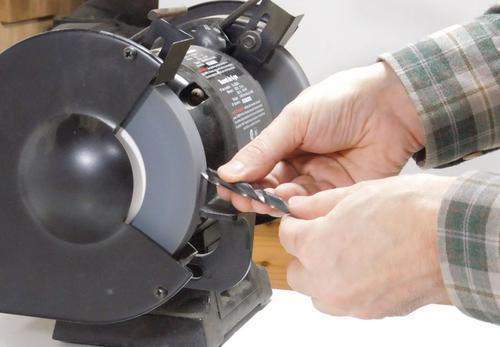 The important thing is that the cutting edge ends up the most forward part of the drill,
that the point stays centerd, and that it's symmetrical. I typically work on alternate sides,
keeping the drill held in my right hand, while flipping it 180 degrees with my left
hand. That way, I keep a consistent hold going from side to side, which should maintain
symmetry.
The important thing is that the cutting edge ends up the most forward part of the drill,
that the point stays centerd, and that it's symmetrical. I typically work on alternate sides,
keeping the drill held in my right hand, while flipping it 180 degrees with my left
hand. That way, I keep a consistent hold going from side to side, which should maintain
symmetry.
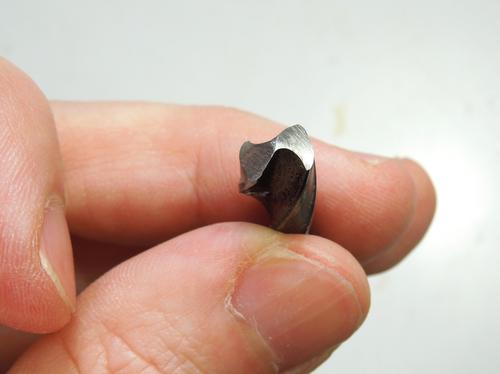 Here's a freshly sharpened drill bit.
Here's a freshly sharpened drill bit.
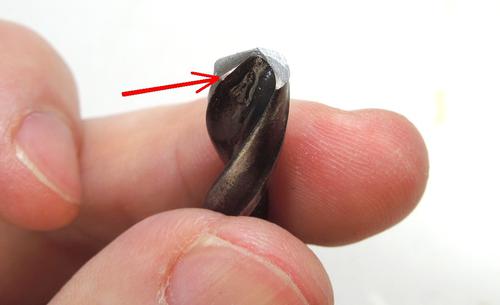 An easy mistake to make is to sweep away too much towards the back, and accidentally
nick the opposite, just sharpened cutting edge of the drill. I did this deliberately on this
one, see red arrow.
An easy mistake to make is to sweep away too much towards the back, and accidentally
nick the opposite, just sharpened cutting edge of the drill. I did this deliberately on this
one, see red arrow.
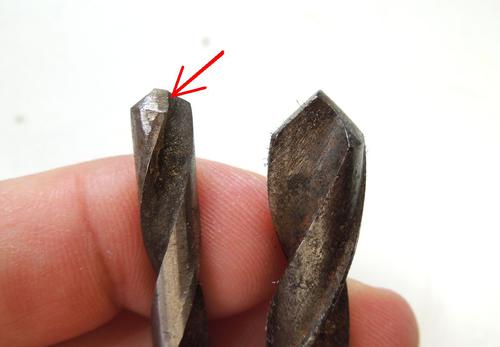 These drills here came with some used junk I bought. The one at left is really messed up.
Somebody ground away the cutting edge, without relieving towards the back. Now the cutting
edge is actually not the most forward thin, so drill is basically unusable.
These drills here came with some used junk I bought. The one at left is really messed up.
Somebody ground away the cutting edge, without relieving towards the back. Now the cutting
edge is actually not the most forward thin, so drill is basically unusable.
The drill at right is sharpened at an odd angle - 45 degrees swept back, but it should still be usable. Just not ideal.
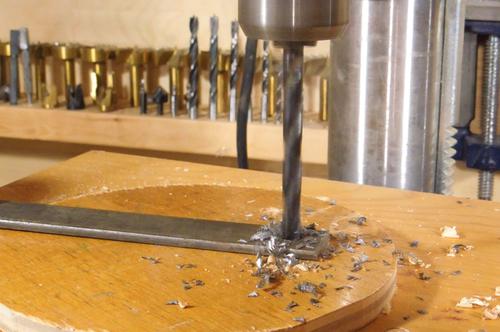 With a good sharp drill, drilling through metal works fine. Although with a hand drill,
drilling in metal will always be hard work because so much force is needed.
With a good sharp drill, drilling through metal works fine. Although with a hand drill,
drilling in metal will always be hard work because so much force is needed.
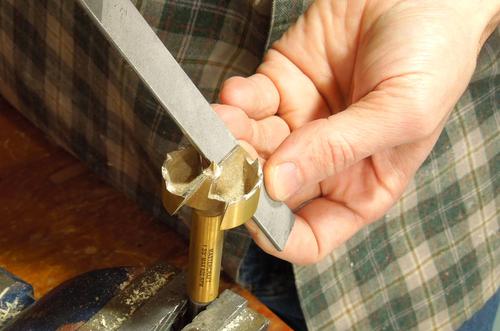 I also sometimes resharpen Forstner bits. I bought
a really cheap set of bits that is supposedly titanium coated. It was kind of
a shame, because they weren't that sharp to begin with, and by the time the bits
are sharpened, the titanium coating is ground away.
I also sometimes resharpen Forstner bits. I bought
a really cheap set of bits that is supposedly titanium coated. It was kind of
a shame, because they weren't that sharp to begin with, and by the time the bits
are sharpened, the titanium coating is ground away.
This one being a cheap one, I can just go at it with a file.
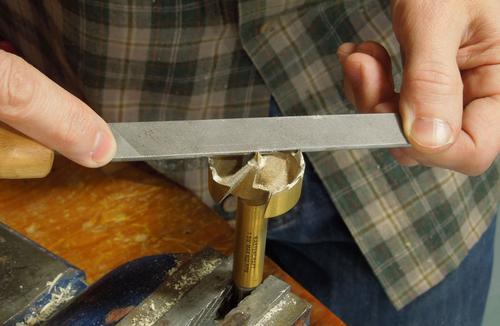 I sharpen the main cutting edge from the side and from the front.
When sharpening from the front, you have to be careful not to nick the cutting teeth
around the perimeter with the file. But it's best to sharpen from the front - there's much more
depth in that direction, so it can be sharpened more often.
I sharpen the main cutting edge from the side and from the front.
When sharpening from the front, you have to be careful not to nick the cutting teeth
around the perimeter with the file. But it's best to sharpen from the front - there's much more
depth in that direction, so it can be sharpened more often.
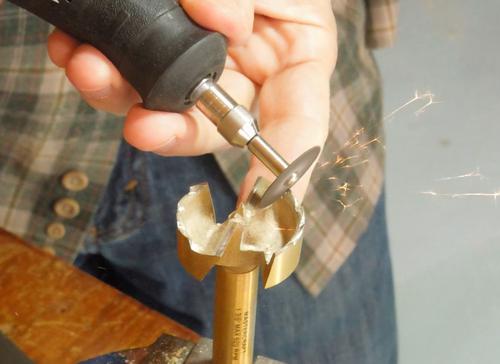 The teeth on these drills are best sharpened with a Dremel tool and a cutoff disk.
The teeth on these drills are best sharpened with a Dremel tool and a cutoff disk.
If your drill has no teeth, then a small stone on the end of a Dremel is best.
You can also use a larger cutoff wheel to sharpen the main edge, similar to what I did with the file.
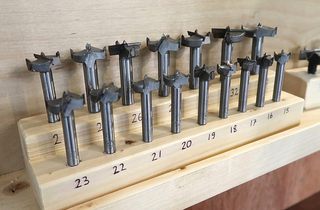 Making a drill index for Forstner bits (video only)
Making a drill index for Forstner bits (video only)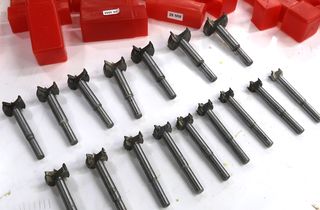 Cheap fortsner bits: Low quality but they drill ok (video only)
Cheap fortsner bits: Low quality but they drill ok (video only)